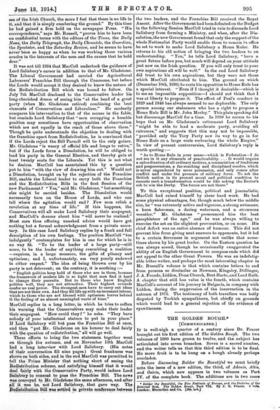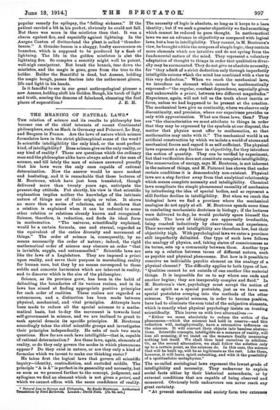THE GOLDEN BOUGH.* [COMMUNICATED.]
IT is well-nigh a quarter of a century since Dr. Frazer brought out his first edition of The Golden Bough. The two volumes of 1890 have grown to twelve, and the subject has articulated into seven branches. Seven is a sacred number, and the writer tells us that this third edition is to be final No more fruit is to be hung on a bough already perhaps overladen.
Before discussing Balder the Beautiful we must briefly note the issue of a new edition, the third, of Adonis, Attie, and Osiris, which now appears in two volumes as Part IV. of the complete book. The additions are in two cases Goldor Buriotiful, Go Sirs Fostiocas V_Earopo. and the DoOritio of Beta. mat Soul. The Golden Bough, Sart. VII, By I. G. Fraser. 2 Tole, PentISS? 344S0.111. fimi Pop
£a,*
of great importance and amount to substantial alteration. They concern (1) the interpretation of the great Hittite frieze at Boghas-Keui, and (2) the origin of the cult of Osiris. The frieze, it will be remembered, represents the great hieros games of the Mother-Goddess, with a bearded divinity in Hittite dress, carrying a trident-like symbol. This divinity Dr. Frazer formerly interpreted as the Hittite equivalent of Tammuz, Adonis, and Attie. He now, following Dr. Garstaug, and having regard to the facts that the god is bearded, carries a trident-like thunderbolt, and heads a procession of men, inter- prets him, we are sure rightly, as the Hittite Thunder-God. This is the more satisfactory, as it allows the Hittite Adonis to be identified with a young male figure following the Mother, the only male in the procession of women. The new interpretation is clear gain all round. As for the cult of Osiris, Dr. Frazer now inclines to a euhemeristio view. Following Dr. Badge, be lays stress on the analogy between the customs of the modern African and the ancient Egyptian, and believes that behind Osiris there may lurk the figure of an actual dead King. The argument deserves the most careful and detailed attention from scholars and anthro- pologists alike.
With Balder the Beautiful a great work comes to its close, and the Cambridge "King of the Wood" pauses to draw breath. That The Golden Bough should close with the Beautiful has a quite special fitness, for it is part of Dr. Frazer's peculiar magic to lend to facts and scientific details that might be dryasdust a sort of golden sheen. His writings are always literature, and flush sometimes into the purple of poetry. Hence his appeal to constructive minds that desire to imagine as well as know.
We turn first to two points on which Dr. Frazer tells us he has definitely changed his mind. It is this power of his to change his mind that makes Dr. Frazer so living a force. He is not of those who boast that he can preach last year's sermon ten years hence. Nor is he of those who sidle cautiously from one view to another, and save their face by a pretence that new truth is but the old restated. In his single devotion to truth there is no place for personal subterfuge.
The first and chief change is in the explanation of Fire Festivals. In previous editions Dr. Frazer followed in the main Mannhardt, and explained the Fire Festival as solar, its object being to promote the sun's heat. He now holds that the solar theory
" is very slightly, if at all, supported by the evidence and is probably erroneous. The true explanation of the festivals I now believe to be the one advocated by Dr. Westermarck himself— namely, that they are purificatory in intention, the fire being designed not, as I formerly held, to reinforce the sun's light and heat by sympathetic magic, but merely to burn or repel the noxious things, whether conceived as material or spiritual, which threaten the life of man, of animals, and of plants."—(Preface, p. vii.) Dr. Frazer has good reason for changing his view. First, there is the important fact that the people who practise fire-customs give purification, and not the solar theory, as their reason. The popular explanation of popular cus- tom M certainly not to be rejected without grave cause, least of all in this case, for the idea of fire as a thing that destroys is simple and obvious, whereas the idea of fire as emanating from and magically connected with the sun is much more difficult and remote. This con- nexion was ultimately made; that is clear from the burning wheels rolled down hills, and also probably from the choice of dates for bonfires—i.e., the summer and the winter solstice But the connexion need not have been primary. Dr. Frazer might have added—it is possible that it may have escaped us in some note—the obvious and interesting fact that our own popular word "bonfire" confirms his present attitude. The word "bonfire" is not, as used to be held, ban-feu, fire of rejoicing ; it is bane or bone-fire (ignis ossium), a fire for burning up old bones and rubbish of every kind. As Marlowe says—
"But ere I die these foul idolaters Shall make me bonfires of their filthy bones."
Purification and the rubbish-heap first, and only later, because of the splendid blaze, jollification, at the birth of an heir or a national victory. In his perfect candour and his desire to make a bonfire of an old error of emphasis Dr. Frazer now, we think, scarcely stresses enough the inherent
double-edgedneas of human thinking and feeling. Humanity, thank God ! is never satisfied with destroying, with negative criticism. Out of riddance springs inevitably and almost instantly magical induction ; out of destruction, construction ; out of purification and abstinence, sanctification. ..L:stotle, with his amazing insight, saw and said that poetry had two forms praise, which issued in hymns and heroic poetry (irca,me); blame, which yielded iambic satire (447000). Aristotle could not and did not consciously know that these two modes arose out of two ritual forms. The ritual of expulsion, riddance, cursing, and, finally, purification issues in the literature of blame; the ritual of induction, of blessing, in the literature of praise. It is all summed up in the old ritual formula: "Out with Hunger, in with Health and Wealth." We analyse and distinguish, but at bottom there is one doable-edged impulse. Possibly, probably, fear is before hope. The history of man's religious development from superstitious fear to faith and hope and charity is largely the history of the shift from bone-fire to bon-feu.
The second change of standpoint is one to which all scholars will probably give whole-hearted welcome. Dr. Frazer formerly held that the great Indo-European god, called by the Greeks Zeus and by the Romans Jupiter, was primarily a personification of the sacred oak, and only in the second place a personification of the thundering sky. He now inverts the order of the divine functions, sky.god first, oak-god second. And why ? For a simple common-sensical reason. Mr. Wards Fowler has shown that statistics prove the oak, of all European trees, to be most often struck by lightning. The oak and the thunder are connected, not because the oak reaches up to the sky, but because the sky-god chooses out the oak for his own, marks it, blasts it, sanctifies it with his lightning. The King of the Wood is not merely or primarily the impersonation of the sacred oak, he is king of, magical maker of, the "weather." The statistics about the oak and the lightning were collected by specialists in forestry who had no mythological axe to grind. The explanation of the undoubted fact is not certain, though experiments on the conductivity for electricity in wood go to show that the oak, being a starchy tree, is among the good conductors. "It was found that a single turn of Holy's electric machine sufficed to send the spark through oak-wood, but that from twelve to twenty turns were required to send it through beech-wood."
We come to Balder and the mistletoe and the External Soul. A strange conjunction it might seem, but really, when once understood, simple enough. Simple to us now because Dr. Frazer has toiled for twenty-five years that we may understand the simplicity and the perversity of primitive thinking. And first the Golden Bough is the mistletoe; Virgil only compares it to the mistletoe :— "Quale solet silvis brumali frigore viscum Fronde virere nova, quad non sua seminat arbos, Et croceo fetu teretis circumdare truncos. Tails era species auri frondentis opaca Dice, sic leni crepitabat bream vento."
There are two mistletoes, Viseum album and Loranthua europaeue, both common in Italy, and Virgil seems to have unconsciously made his Golden Bough out of a compound picture. He was poet, not botanist. He knew Viseum album, our common mistletoe, whose pale-green tufts turn con- spicuously yellow in winter. It is very rarely found on oaks. He knew Loranthus europaeus, with its brilliant yellow berries ; unlike the common mistletoe, it does not put forth fresh leaves "in the cold of winter solstice." Balder the oak-god was slain by the mistletoe The mistletoe is everywhere magical for life as for death, and specially for life. We remember Pliny's account of the solemn cutting of the mistletoe by the Druid priests : "they bail it as the universal healer." The priest climbs the oak-tree, cuts it with a golden sickle, and the bough is caught in a white cloth. " They believe that a potion prepared from mistletoe will make barren animals to bring forth, and that the plant is a remedy against all poison" (Pliny, Nat. Hist., XVI., 249-251). And why this sanctity P Because, first and foremost, the plant was evergreen; when the oak leaves died and fell the mistletoe turned to gold. Surely in it was the life, the External Soul, of the tree, and the life of the tree could bring life and health to man. It hung between earth and heaven, and it might not touch earth, so great was its sanctity. The mistletoe cannot fall, rooted as it is high in the tree; home it was
popular remedy for epilepsy, the "falling sickness." If the patient carried a bit in his pocket, obviously he could not fall. But there was more in the mistletoe than that. It was a charm against fire, and especially against lightning. In the Aargau Canton of Switzerland the plant is called " thunder- besom." A thunder-besom is a shaggy, bushy excrescence on branches, which is supposed to be produced by a flash of lightning. The life in the golden mistletoe is also the lightning fire. So complex a sanctity might well be potent, well-nigh omnipotent. But break the branch, tear down the mistletoe, and the magic is gone, gone from the tree to the holder. Balder the Beautiful is dead, but Aeneas, bolding the magic bough, passes fearless into the nethermost gloom, life and light in his hands.
Is it fanciful to see in our great anthropological pioneer a new Aeneas, holding aloft his Golden Bough, his torch of light and truth, scaring the demons of falsehood, cleansing the foul












































 Previous page
Previous page